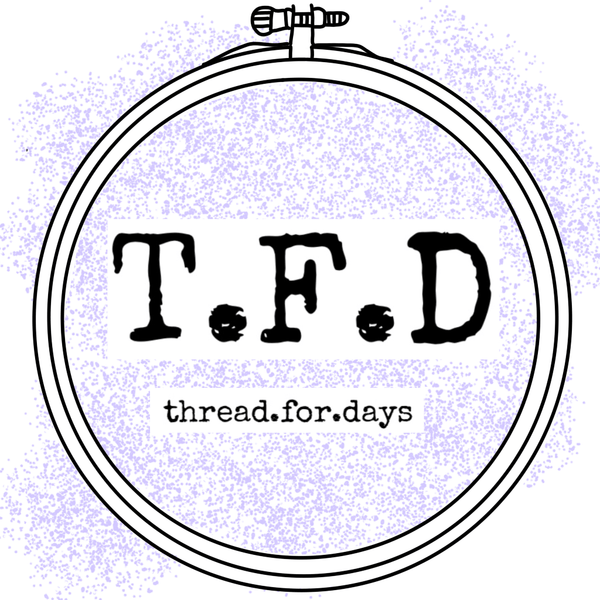If you didn't know, I make embroidery patterns!

Part of my art journey is really exploring digital art and pattern making. My process typically involves a path of; 1. inspiration, 2. artistic vision, 3. reality, 4. making it happen.
In this blog post I wanted to talk about the process of making these embroidery patterns and the considerations I take to translate an artistic vision into stitching.
Expectation vs. Reality

I get my inspiration from things that bring me joy; this usually means my everyday interests mashed with pop culture references. I often have grand visions of a cool project filled with complicated stitches and making it into a rad embroidery pattern, but the reality is while maybe I can stitch the thing and understand where I want it to go, it may not translate well into a pattern (that others will need to follow).
Before I begin stitching there is a process I usually go through to take my internal vision and make it a possibility. This is especially important for pieces that I hope to turn into a PDF pattern because other people need to be able to read the pattern and follow the instructions.
Things to Consider Before Drafting a Pattern
1.Who is the pattern for?

The way I translate a design is very different depending on if it is a one-off art piece or commission or if it is something I intend to draft into a pattern.
If it is a one-off art piece I give myself a lot more flexibility and space to play and change the design as I stitch. If I am making a piece as a commission or for myself, I am a lot more lax in the design (I might even just draw an outline as a pattern and fill the details as I go.
If I intend to make the piece into a pattern, I know that I need to draw the design in a way that is easily explainable to others. In addition to this, when I do make my PDF patterns I like to draft them for beginner-intermediate embroiderers- so I know that the design must be simpler and include no more than 3-4 different stitch types. (this is not a real rule, but something that I prefer to stick to).
2.The design itself: size is important!

When I first draft my design I go full out. I draw whatever I feel looks good.
Once I have that design, I know I need to make some edits. While having some fine detail in say, for example, eyes, may look really cool in my digital art sketch- it might not be realistic when that part of the the embroidery piece is incredible tiny; unfortunately I cannot zoom into my fabric.
It is in draft two that I consider how much detail I want to put in and what detail I want to make with thread vs perhaps watercolors. It is here where I also consider the size of hoop I think would work best for the amount of detail I want.
This step is important for both one-off pieces and pattern making!
3. Consider the stitches

Once I have the design in mind (sometimes while I'm designing the pattern for my PDF's) I try to keep in mind and definitively decide on the stitches I want to include in my piece.
If the piece uses a lot of outlining I think about how I want it to look: backstitch vs split backstitch, vs whipped backstitch, or even a running stitch for dashed outlines.
If there is a lot of filling I think about if I want that filling to be flat (satin stitch or long and short) or if I want it to be more textured and filled with something like a French knot.
In addition to this I think about the parts of the design that are "important" (I want to stand out) vs want to fade a little bit, this helps me decide the number of threads in each stitch.
4. "readability" are these choices easy to explain and visually map?

Finally we come to my last consideration when drafting a pattern is the "readability" of the pattern!
I take a look at my design, the choices I made, the stitches I used and take a moment to think about if this pattern is something that I can easily explain to someone and map out visually in a PDF.
For my patterns I make 3 different guides; the printable pattern you trace, the stitch guide, and then the colour guide. I want to make sure that if someone else reads it, they know what to do.
If I am making patterns for myself for an art piece or commission, this also kind of applies. When I transfer my design and start stitching, the pattern/design needs to be readable for me too. I have had a couple designs when after transferring I had 0 idea what past me was doing; so make sure you can follow your own pattern.
So don't skip this consideration!
Let's wrap it up:
There is lots to consider when designing your own embroidery pieces and these have been just a few things I consider when I am making my own designs.
Whether you are designing for yourself or designing for others to follow really, just have fun with the process!
I hope this post gave you a little bit of inspiration,
Happy stitching!
~Kass

